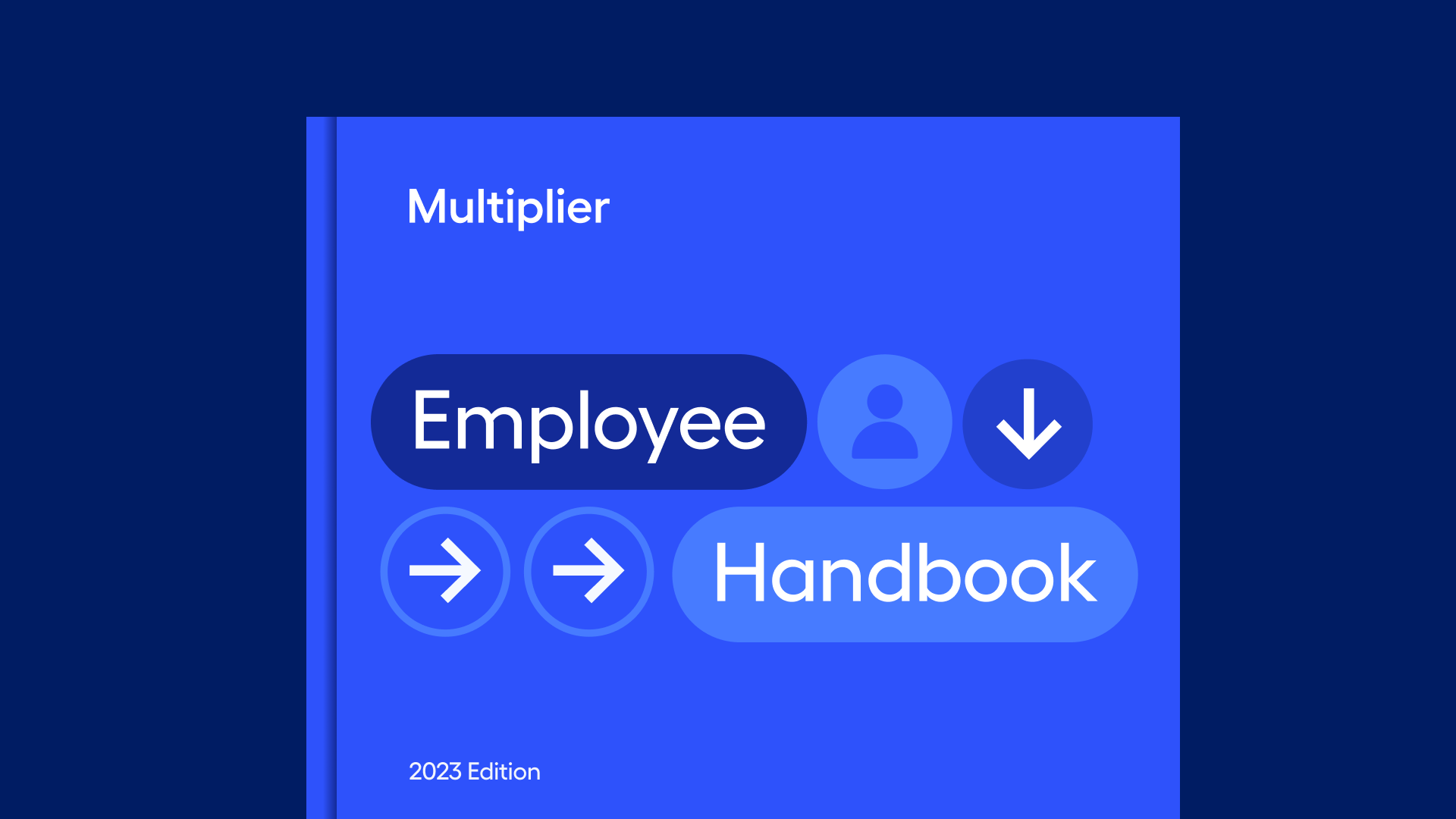A handbook for your employees is crucial for fostering a positive workplace culture, but many businesses don’t know where to begin…
The humble employment handbook might not seem like the most exciting document to distribute around your business, but the chances are it’ll end up being one of the most important you ever make.
A valuable resource for both employees and employers, the handbook serves as a foundation for fostering a positive workplace culture: a handily centralized source of information that covers pretty much every area of the business.
While it might not make for great bedtime reading, getting your organization’s policies, procedures, rules, and guidelines keeps everyone on the same page—literally. Vital when it comes to establishing the expectations of your employees in terms of conduct and performance, the handbook can also help reduce legal risks from compliance with labor laws and regulations, helping protect your company’s reputation as well as offer your employees peace of mind.
If you’re reading this article, you get it: employment handbooks for enterprises and small businesses are a step you can’t afford to skip.
But where, you ask, do I begin?
The Key Elements of the Employment Handbook
Creating a sound employment handbook—also known as employee handbook or employee manuals—may seem like a daunting task.
Just to complicate matters, each handbook needs to be bespoke to your company’s culture, industry, and size, crafted in collaboration with experienced legal and HR professionals, as well as current employees. All that requires a lot of research, teamwork, and feedback but, to get you moving, here are some key elements your handbook should always have:
1. Introduction:
It sounds like a simple place to start, but opening your handbook with a few words on your business’ mission, values, and beliefs is an important chance to establish the purpose and importance of the rest of the document. As the old saying goes: You should start as you mean to go on.
2. Employment Categories:
Take time to explain the definition of the employment categories found within your organization, such as full-time, part-time, or contract workers, and the eligibilities of each of these classified groups.
3. Equal Employment Policies:
Making explicit the policies promoting non-discrimination and equal opportunities for employees is not only an important legal standard to maintain, but also makes clear that everyone within the organization will be treated fairly and without bias. A diverse, safe, responsible workplace is an environment in which employees of all kinds have equal opportunity to thrive.
4. Code of Conduct:
The employee handbook is all about codified expectations. Perhaps that is most important with regards to conduct. The professional behaviors and ethics set out create guiding principles that take precautions against immoral actions that can put the integrity of the business and the safety of employees at risk. This section could also include information on procedures like filing complaints.
5. Employment Policies:
If the code of conduct refers to the overarching ethical principles that form the boundaries of your company’s culture, employment policies provide the day-to-day rules that help the workplace run. These policies can vary from organization to organization but, in principle, they’re concerned with issues such as attendance, punctuality, dress code, paid time off, workplace safety, and use (or misuse) of resources. This section could also highlight the guidelines for appropriate employee behavior on social media.
6. Compensation & Benefits:
Payroll schedules, overtime guidelines, information about bonus and commission packages, as well as on 401K or pension plans can be found here, alongside details of company benefits, such as health insurance.
7. Safety, Security, & Privacy:
While you may think your employees don’t need to be warned about privacy as it pertains to their work, it never hurts to spell out the importance of taking all necessary precautions, especially with regards to resources like work email accounts and company hardware. This section could feature more physical concerns with safety, such as emergency protocols and the procedures for reporting safety concerns.
8. Performance Reviews:
Providing clarity on the performance evaluation process helps employees understand what to expect during reviews. Such guidelines also help curb accusations of favoritism and bias when everyone understands the criteria by which they will be judged.
9. Termination:
Never a nice thing to happen, but it’s important that due process is outlined in the event of employee termination. Such procedures are there for all-round protection, ensuring the process is fair and legal. Employees are made aware of their employment rights while the risks of wrongful termination claims are mitigated for employers.
10. Acknowledgment & Agreement:
This is a crucial section which requires the signature of your employee, signifying that they have read, understood, and accepted the handbook, its rules and regulations. This is an important legal step: should the employer fail to live up to its own guidelines, the employee has evidence in writing. And likewise, if an employee doesn’t abide by the company policies, the handbook can provide valuable defense against potential legal claims.
Benefits & Common Mistakes
The benefits of having a rock-solid employment handbook are there for all to see.
The clarity and expectations provided by outlining company policies and procedures ensure a clear line of communication between the business and its employees. And important information about legal protection and cultural alignment, as well as commitments to anti-harassment and diversity fostering a safe environment for everyone in the company to focus on their interpersonal and professional development.
For small businesses, a handbook can help define roles, responsibilities, and the rules that guide them, helping build a solid framework for success, sustainability, and growth.
For larger enterprises, where high-touch onboarding is less possible, such a document helps maintain consistency across staff—old and new—in various locations, which can really serve towards protecting your corporate reputation.
But a badly drawn-up handbook can risk impending disaster. As such, learning from those who came before you—who fell so you may watch out for the crack they tripped over—is a solid gameplan.
Here are some common mistakes companies make when creating an employment handbook:
1. Inconsistency & Ambiguity:
A failure to maintain a consistency in language and formatting throughout the document can lead to confusion for its readers. Using overly formal language can render well-intentioned policies vague and ineffective, causing misunderstandings, disputes, and increasing the likelihood of legal action.
2. Forgoing Legal Reviews:
Speaking of which, skipping the step of legal counsel reviewing the document and its contents before its distribution can result in policies which are non-compliant with employment laws.
3. Irregular Updates:
Along similar lines, changes in laws and regulations happen all the time. While you want to maintain consistency of message within the handbook, the document should be regularly reviewed to ensure that it maintains compliance and relevance for the company it represents.
4. Not Customizing To Your Needs:
Following a template is all well and good (and we’ll be talking more about that in the section below), but companies should take time to ensure that handbooks are specifically tailored to the nature of their business, its culture, industry, and headcount. A great way to keep yourself vigilant in this area is to invite employee input (or the input of their representatives) to make sure that the document “feels right” to the company it seeks to safeguard. Skipping this collaboration process can also lead to a lack of employee buy-in: Employees—just like everyone else—want to feel seen and heard.
5. Inflexibility:
The handbook is an important way to keep your company on the right track, but that doesn’t mean there may not be occasions where certain circumstances may necessitate a little flexibility in the rules. For example, if a certain regional office under your umbrella is prone to extreme weather conditions, a flexible interpretation of otherwise rigid work-from-home policies may be necessary. A failure to include reasonable wiggle room from time to time can lead to frustration within the workforce and affect productivity.
6. Excluding Acknowledgement Section:
While it may only be a very short section, it’s important to include a section requiring a signature indicating the handbook was read and agreed to. A failure to include this section makes it harder to prove legal compliance and to hold employees accountable to the standards and values of the business.
7. Not Communicating Importance of the Handbook:
Working hard to craft a well thought-out handbook but forgetting to communicate the genuine importance of the document and its contents is one of the most common mistakes around. Providing adequate orientation on the policies of the handbook helps to underline its significance, and ensure that the guidelines throughout do not go unnoticed.
Creating an Employment Handbook: Step-by-Step Guide
By now you should know the rough shape of a solid employment handbook as well as the benefits and potential pitfalls of creating this all-important document.
Here’s a brief step-by-step guide on how to begin creating your business’ employment handbook:
1. Understand Your Objectives:
What is the purpose for creating your handbook? And no, you can’t say Someone told me that I should make one. Whether it is for onboarding new hires, making clear company policies, or both, understanding the company motivation behind the handbook is essential.
2. Find A Template That Suits Your Needs:
It’s important to note that you should choose a template that will be the right fit for your company. Choosing an enterprise-level template for your small business, for example, may be overkill.
3. Chat To The Lawyers:
As we mentioned earlier compliance and protection is a core benefit of a watertight handbook, and getting a legal professional to work with you to ensure rigor when pulling together the elements of your document.
4. Get Early Employee Input:
Templates come with pre-written content suggestions but roping in fresh eyes from the ranks of your staff is a great way to make sure you stay on the right course. Asking employees about their key questions and concerns around workplace policies and endeavoring to answer those within the handbook will underscore its relevance, as well as increasing the chance of employees embracing the document.
5. Get Writing (& Rewriting):
Most handbooks are around 30 to 100 pages in length and, sadly, they will not write themselves. Approaching the task as a collaborative affair—with HR and legal professionals, and your employees—helps establish an interactive approach to its drafting. It doesn’t need to be the finished article straight away, but given the importance of a great employee handbook, you’ll need to canvas feedback along the way, especially when it comes to comprehension and readability. Remember: Clear is kind. Unclear is unkind.
Examples Of Well-Structured (And Not Boring) Employment Handbooks
Understanding what is required of your handbook is one thing; presenting that information in a way which ensures maximum impact is quite another. But while it’s imperative to get your points across to employees,
Here are 8 examples of employment handbooks which toe the line between design and detail. Feel free to pilfer ideas liberally from each. We won’t tell a soul:
- Netflix: Probably the most famous handbook around (read online well in excess of 17 million times), Netflix CEO Reed Hastings and Chief Talent Officer Patty McCord foregrounded culture in a big way. With an estimated worth of $156 billion, it’s safe to say it paid off. As McCord summarized for HBR: Trust people, not policies, and always reward candor.
- Hubspot: Keep it simple. Utilizing the PowerPoint medium to its fullest, Hubspot goes to show that it’s not the tech but what you do with it—and keeps pace with its transparency goals by uploading the whole thing online for anyone to access.
- Disney: On the other end of the scale, you have Disney. While this 1943 handbook is overdue updating on the content side, its ethos of simple yet evocative copy and beautiful illustration remains timeless.
- Austin Fraser: Similarly—but from this century—tech recruitment agency Austin Fraser produced a physical, hardback book, brilliantly designed. While their work might focus on the digital, their handbook ensures that the tactility of recruitment is not forgotten.
- Facebook: A highly visual handbook for one of this century’s truly innovative companies. Facebook’s handbook from 2015 typified its approach of big ideas presented in immediately recognisable ways (full-spread taglines and eye-catching iconography) and delivering more in-depth matters in a typically conversational tone.
- Trello: For a project management tool, you’d expect Trello to pride itself on its simplicity and accessibility when communicating with its staff. Its masterstroke? Presenting the handbook inside the format of the Trello app.
- Disqus: Life (and work) is all about balance. Blog commenting tool Disqus’ brisk 25-page document makes sure the important compliance policies are clear, and the more human elements are presented in a reader-friendly mix of illustrated graphs, fun graphics, and memes.
Conclusion
Hopefully this information has equipped you with the inspiration to go out there and create a culture-shaping handbook for your employees. This document will be the first your new hires read and one your current staff will refer to time and time again: Make sure it’s something you’re proud of.
FAQ
1. What should be included in an employment handbook?
An employment handbook should include policies on work hours, leave, performance expectations, and code of conduct. It should also outline compensation, benefits, and safety measures to ensure a safe and secure work environment.
2. Is it necessary to have an employment handbook for a small business?
In a small business, an employment handbook can be quite helpful since it offers guidelines for employees to minimize confusion and disagreements. But it’s not an absolute must: you can convey essential information verbally or via email, which may be a better fit for your business’s size and requirements.
3. How do I create an employment handbook for my enterprise?
First, you should outline your company’s policies and values, then organize them into clear sections. The handbook should then be customized to your business’s unique needs and its market requirements, including legal compliances. Consider consulting with employees, legal and HR professionals for a well-rounded approach.
4. What are the legal implications of not having an employment handbook?
The absence of a handbook leaves your business vulnerable to misunderstanding and misinterpretation. A well-structured document establishes clearly communicated expectations and regulations to ensure compliance with employment laws.
5. What policies are typically covered in an employment handbook?
Codes of conduct, work hours, leave, compensation, equal employment opportunities, and conflict resolution procedures are usually covered.
6. How often should I update my employment handbook?
Annually, or as employment laws change.







